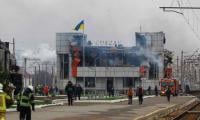According to the unofficial results of the second phase of the Khyber Pakhtunkhwa (KP) local government elections that were held in 18 districts on March 31, the PTI has emerged as the leading party. Out of the total 65 tehsil mayor/chairperson seats, the PTI has won around 30. On the other hand, the JUI-F, PML-N, ANP, PPP and independent candidates have won the remaining 35 seats.
The JUI-F has won nine seats; independent candidates nine; the PML-N five; the JI five, the ANP two, the PPP two, the QWP one, the MWM one and the RHQ one. The PTI’s domination can be judged from the fact that it has won almost half of the seats. The PML-N, PPP and JI are the real losers of this election.
The districts where polling was held were: Abbottabad, Mansehra, Battagram, Torghar, Kohistan Upper, Kohistan Lower, Kolai-Palas, Swat, Malakand, Shangla, Lower and Upper Dir, Upper and Lower Chitral, Kurram, Orakzai and North and South Waziristan.
The most recent political developments in Islamabad and Punjab overshadowed the KP election results, as people were more focused on the no-confidence motion against Imran Khan in the National Assembly and the election of the new chief minister in Punjab, after the resignation of CM Usman Buzdar.
The results clearly show that the PTI is still popular in KP and can pose a serious challenge to its opponents. This win is a morale booster for the PTI in these depressing times. It seems that this victory is likely to go a long way in keeping the party united regardless of other domestic politics.
After the defeat in the first phase of the local bodies elections in December 2021, the PTI-led KP and federal governments made better strategies, and Imran Khan led the election campaign himself. It was a do-or-die election for the PTI, as the defeat could have opened the floodgate of defections.
The PTI leadership knew the importance of this election, and this is why Imran Khan organised public rallies in different districts despite facing the threat of the vote of no-confidence. He continued to do so, despite notices and fines from the Election Commission of Pakistan (ECP). PTI ministers and the KP government continued with the campaign and lured voters with promises of development work and mega projects.
Different factors contributed towards this victory. Soon after the shocking defeat in the first phase of the elections, the PTI leadership seriously analysed the situation and changed its strategy for the second phase. Veteran politician Pervez Khattak was made the provincial president of the PTI, and he led the campaign. The PTI mobilised government resources, and Imran Khan’s involvement in the campaign mobilised and charged PTI activists and supporters who fully backed their candidates and worked for their success.
It is true that the PTI provincial government is a major factor in this victory because local governments need support and funding from it. But it is not the only factor in this victory.
The absence of main opposition leaders in the election campaign of their respective parties also played a big role. The PML-N and JUI-F leadership didn’t organise a single public rally throughout the campaign. They were busy in Islamabad to accomplish the mission of gaining the support of 172 members in the National Assembly to oust the PM.
The PTI has even performed well in the districts dominated by the JI and the PPP in the past. The PTI has won five out of the seven tehsils of the Lower Dir district. Over all, the PTI has performed well in Malakand Division that used to be the stronghold of the JI, PPP and ANP before the rise of the PTI.
The PTI swept the Swat, Malakand, lower and upper Dir districts in the 2018 general elections as well. And it has now successfully maintained its grip on these districts. Both the JI and the PPP failed to regain the lost ground in the Malakand division since the 2018 general elections.
The JUI-F once again performed well in these elections. It failed to dominate like it did in the first phase when it emerged as the leading party with 23 seats. But it has successfully retained its stronghold in different districts. It came second with nine seats and cemented its position as the main contender against the PTI. In many tehsils where PTI candidates have won, candidates from the JUI-F are the runners up.
The PTI also performed well in Hazara Division which was traditionally considered the stronghold of the PML-N and some political heavyweights who prefer to contest elections as independent candidates.
But the PTI has been making big inroads into this region since 2013. The PML-N defeat in the Hazara region is a big political setback for the party which failed to dominate its traditional stronghold. It managed to win just five tehsils out of the total 22. The rest went to the PTI, independent candidates and the JUI-F.
It seems that the PML-N will not be able to regain this lost ground in Hazara without overcoming its internal differences. It has failed to achieve consensus on candidates to compete against the PTI. The main issue for the PML-N seems to be its weak organisation. The party was a dominating political force in Hazara, but the rise of the PTI has seriously damaged it. And the party hasn’t been able to sort out its internal differences.
The PPP has performed poorly in the second phase of the elections, like it did in the first phase. The party was a powerful political force in Malakand, but it has lost support over the years. It needs to seriously strategize how to overcome its political and organisational crises in KP and needs serious soul-searching to prepare a better strategy in KP.
The recently held election results clearly indicate that the PTI is still a force to reckon with, at least in KP. It may be down, but it is not out yet.
The writer is a freelance journalist.















